|
| |
|
We've Come a Long Way, Baby
QUESTION:
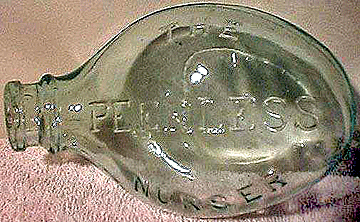 I discovered an unusual
bottle in a box lot I bought at a local house sale. The bottle is about
six or seven inches long, pale green, and oval but doesn’t have a flat
bottom, so it must lay on its front or back. Do you have any idea what
this little bottle would have contained or been used for? I discovered an unusual
bottle in a box lot I bought at a local house sale. The bottle is about
six or seven inches long, pale green, and oval but doesn’t have a flat
bottom, so it must lay on its front or back. Do you have any idea what
this little bottle would have contained or been used for?
Thanks,
Carol
______________________________________________________
ANSWER:
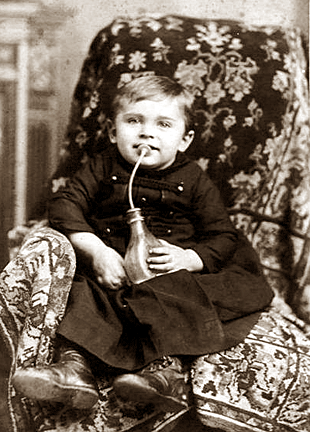 Believe it or not, your little bottle once
held baby’s milk. Believe it or not, your little bottle once
held baby’s milk.
The development of baby bottles took centuries to transform into the
sterile plastic throwaways parents use today. As knowledge of germs
and hygiene developed, so did the infant feeder. While parents of
earlier times sensed that babies who were breast fed had a better
chance at surviving, it wasn't until the early 20th century that
mothers and bottle makers realized that clean, sterile feeders were
necessary to protect a baby's health.
Before then, bottle makers created a variety of feeders—from tiny
coffeepot-shaped ones of tin to china submarine-shaped flasks
decorated in Flow Blue and transferware patterns. Glass bottles
didn’t come on the scene until the mid-19th century.
Nipples, made of wood, ivory, bone, sterling, pewter, leather„ rags,
sponge, rubber, and yes, a pickled cow's teat, were nothing like
those in use today.
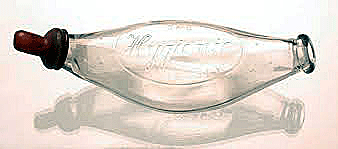 Much like today, bottles were necessary because some mothers
couldn’t breast feed, and, unlike today, it wasn’t always
fashionable to nurse. When a friend asked Queen Victoria if she
intended to breast feed, she reportedly said she had no intention of
making a cow of herself. Much like today, bottles were necessary because some mothers
couldn’t breast feed, and, unlike today, it wasn’t always
fashionable to nurse. When a friend asked Queen Victoria if she
intended to breast feed, she reportedly said she had no intention of
making a cow of herself.
One manufacturer immortalized Victoria’s image on a stoneware bottle
that’s now prized by collectors. But the queen hated that her
likeness appeared on a nursing bottle.
Besides a dislike, of nursing, there were other reasons for women to
use baby bottles. Many women thought that nursing would destroy
their figures. It also inhibited them socially since they couldn’t
travel and leave the baby at home.
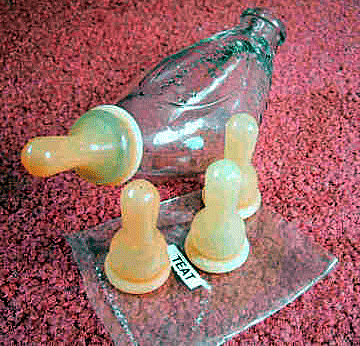 Fathers weren’t too keen on breast feeding, either, because doctors
and midwives often advised mothers to refrain from sex during
nursing. Fathers weren’t too keen on breast feeding, either, because doctors
and midwives often advised mothers to refrain from sex during
nursing.
Wealthier families employed wet nurses, usually young women who had
a child and could nurse another. Since parents believed that a milk
giver’s personality traits could be transferred to an infant through
their milk, choosing the right one was important.
The ideal wet nurse was a plump rosy-cheeked young woman. Many
people believed that red-headed girls gave bitter milk and produced
ill-tempered babies. They even suspected animal milk, believing that
infants took on the attributes of the cow or goat. French nobles
gave the title of “contessa” to a wet nurse so that their infants
could be nursed by milk of noble origin. Those who couldn’t afford
to hire a wet nurse, turned to a variety of infant feeders, many of
them unsafe by modern standards.
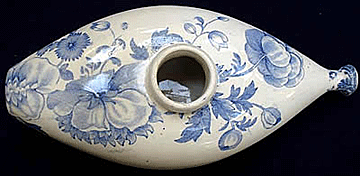 Though a china submarine-shaped bottle with blue transferware is
beautiful, being completely opaque it was hard to clean. Fermenting
milk curds could be lodged in the corners and mothers would never
see them. Though a china submarine-shaped bottle with blue transferware is
beautiful, being completely opaque it was hard to clean. Fermenting
milk curds could be lodged in the corners and mothers would never
see them.
Charles M. Windship of Roxbury, Massachusetts, developed the first
glass baby bottle, a small turtle shell-shaped: feeder, in 1841.
Women thought the shape would fool their infants into thinking it
was a real breast.
To use the Windship bottle, a woman wore it on a harness on her
breast. It was probably difficult to use because girls with tender,
post-childbirth breasts wouldn’t want to place any weight on their
on top of them. Because of its shape, the Windship bottle became
known as a mammary bottle. Today, they’re highly prized by
collectors and sell for nearly $500 each.
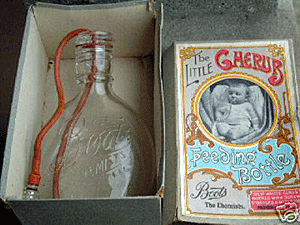 But the Windship bottle wasn’t safe for the baby. The Windship and
some subsequent bottles came with a long rubber tube, topped off
with a rubber nipple. The tube allowed for hands-free feeding for
mothers. These devices also had their problems. Dried formula would
clog the tube which was too small to be cleaned, so bacteria
blossomed. This feeder became known by the onerous name of the
“murder bottle.” New York State banned them in 1906, and other
states rapidly followed suit. But the Windship bottle wasn’t safe for the baby. The Windship and
some subsequent bottles came with a long rubber tube, topped off
with a rubber nipple. The tube allowed for hands-free feeding for
mothers. These devices also had their problems. Dried formula would
clog the tube which was too small to be cleaned, so bacteria
blossomed. This feeder became known by the onerous name of the
“murder bottle.” New York State banned them in 1906, and other
states rapidly followed suit.
The turtle-shaped bottles, begun with the Windship model, remained
in use from around 1860 to 1910. The bottles had vents, sometimes on
both ends, so that air bubbles wouldn’t enter the milk. A nipple
went on one end and a tiny cork on the other.
Most bottles became cylindrical by the beginning of the 20th
century. Sterilization also became routine. And by the 1930s, bottle
makers began embossing their glass bottles with puppies and kittens.
These continued to be used until the invention of the disposable
plastic bottle.
<
Back to Readers Ask Archives
|
|

|
|
FOLLOW MY WEEKLY BLOG
Antiques Q&A
JOIN MY COLLECTION
Antiques and More
on Facebook
LIKE MY FACEBOOK PAGE
The Antiques
Almanac on Facebook |
|
No antiques or collectibles
are sold on this site.
|
|
How to Recognize and
Refinish Antiques for Pleasure and Profit
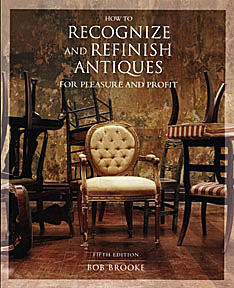
Have
you ever bought an antique or collectible that was less than perfect and
needed some TLC? Bob's new book offers tips and step-by- step
instructions for simple maintenance and restoration of common antiques.
Read an
Excerpt
|
|

|
|
|
|
|
